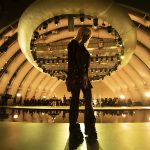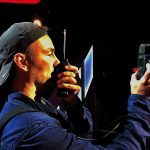Simon Cowell may have just given the haters one more reason to rant about him over the ‘Net. Cowell’s latest creation, La Banda, a weekly singing competition airing Sunday evenings on Univision, has completed its first successful season and was recently greenlit for a second.
Co-produced by former Menudo boy band vocalist and current international singing star Ricky Martin, who also sits on the show’s three-person judging panel, and hosted by Alejandra Espinoza, La Banda discovers and promotes the next big Latin American vocal group.
Exceeding Univision’s anticipated viewership by millions, season one concluded with a five-person boy band, dubbed CNCO, earning a recording contract with Sony Music Latin and a guest slot on Martin’s current One World tour through Puerto Rico and South America. At the time of this writing, PLSN has been told that the singing competition’s second season, La Banda 2, will generate a six-member, integrated Latin music singing group (composed of three boys and three girls), a move that’s sure to further rile up the naysayers.
Whatever you may think of Cowell, his production company Syco Entertainment or its development partners (Univision, Haim Saban’s Saban Brands and co-producer FremantleMedia Latin America), it’s difficult to deny Simon’s track record or the fact that he might just have another reality TV hit on his hands.
Success seems to come easy to Simon, but the behind-the-scenes work is a different story. Season one, which aired from September 13, 2015 through December 13, 2015, broadcast its final seven episodes live on national TV. The lighting and video crews had to rise to the challenge of making the show’s visuals fresh every week while also designing multiple different looks per show and working around pre-packaged video segments. Beyond all this, the crew needed to effectively manage time constraints without raising the intensity of the stress level. PLSN talked with some of the major talents on the La Banda crew to find out how they survive the chaos.
Early Rounds
Similar to many singing competition or talent contests currently on TV, hundreds of applicants are whittled down to a dozen, and excitement builds with each successive week. (More than 10,000 boys from across the U.S., Mexico, Central and South America, Puerto Rico and the Caribbean vied for the opportunity to be a part of the program. Auditions were held in Los Angeles, New York, Miami, Chicago, Houston and Puerto Rico, as well as via the show’s online site: univision.com/entretenimiento/la-banda.)
The show’s early auditions and eliminations were staged in Miami Beach, where singers who successfully completed the first elimination round ultimately advanced to perform a “mini concert,” record a music video and eventually sing before an audience.
“This is Syco’s new production to sell to the world,” says lighting designer Tom Sutherland. “We needed to get it right, and it needed to feel fresh and exciting and big.”
“It’s a different show every week,” says head gaffer Don Winters. “In the final rounds you had 12 contestants and four guests, which equates with producing 16 different shows in one night. One act [Richard Camacho] was singing in the rain for a minute and a half. We had a rainmaker and a gigantic wood pool to capture the water and get it off stage as fast as we could.”
Although the lighting rig remains relatively consistent from episode to episode, the lighting application differs from contestant to contestant and from week to week. To help keep things fresh visually, the lighting team tapped Univision’s lighting gear, which was augmented weekly by rental fixtures from PRG, such as versatile Clay Paky Mythos units (for sharp beams) and Sharpys for beam, aerial and wash effects. The Sharpys were positioned between the set’s video screens and in a semi-circular pattern on the stage, providing floor lighting. Color Kinetics ColorBlast 12TR UVs also provided floor lighting.
One of the unique designs for the show was the two parallel arches, or upside down “U” shaped strips, that spanned nearly the length of the set. Dozens of Philips’ Color Kinetics ColorBlast 12 TR UVs and CE Source 4 PARs formed the two arms of the arches, while Mythos, Coemar Infinity Washes and Spots and Vari*Lite VL5 were stacked in groups of three between them, offering the lighting team perfect placement and coverage for their needs.
“The arches of lights — their placement was perfect,” says Craig Caserta, lighting programmer and director. “The fixtures Tom chose gave us the flexibility that this show needed.”

Lighting design changed dramatically from week to week and from performance to performance. For instance, from week four to week five of the live episodes, the rig included dozens of Chauvet COLORdash Accent RGBW fixtures, which were secured to piping and offered varying degrees of heat and intensity. In addition, 15 Nova Light Nova Flowers formed a grid or light box, Chauvet Nexus 4×4 matrix fixtures provided a warm (somewhat) hazy glow, and 24 Chauvet COLORado 1-Tri Tours helped to create a stadium-light look.
Creative designs abound during the seven-week live shows, including the use of Barco MiStrips, in conjunction with piping, creating elongated light columns and light-strip “chandeliers” (i.e. flown “boxes” measuring six by five by five feet (LxWxH). Each chandelier featured two Clay Paky B-Eye fixtures hanging from the six-foot bottom pipe.
Live Shows
The real visual excitement — and madness — occurs during the final seven live episodes, for which the La Banda crew was tasked with working quickly, efficiently and with a limited but effective measure of planning. Since La Banda runs live on Sunday night, Sutherland requested a sit-down with programmer Caserta on Fridays.
“I’d get the music on Thursday for all 16 performances and then break down the music — chorus, verse, intro — and all the different sections of the song to figure out where cues needed to be,” says Caserta, who uses a grandMA full size with a grandMA Light as backup. (Second programmer Chris Delorenzo runs a grandMA Light as well. “Then we receive the creative document from creative director Brian Burke, which indicates video and lighting design, color schemes, the choreography of video and lighting and the general vibe of the song.”
Caserta wrote cues on the Friday prior to the live performances, based on the creative department’s input. These were 10-hour days, give or take, estimates Caserta, of not only programming but discussing looks with Sutherland, who decided on spot cues. Caserta programmed for 16 songs as the production moved into its “dry blocking” phase (i.e. rehearsals without cameras rolling).
“Craig would have about 10 or 15 minutes to get a number into the desk and then, say, 15 minutes with the artist to rehearse it two or three times,” Sutherland says. “We always had a rough idea of what angle we are going to go with it — what the graphic content was, what colors we would need to be, if there are floor lamps and what we would want those to be.”
On Saturdays, Caserta would log in nine hours and upwards of 600 cues, as camera blocking began and contestants went through their practice runs. Typically, singers would take three passes at each tune, offering the lighting design team a minute or two per pass to adjust for changes. In addition, Sutherland called for updates and tweaks of lighting cues based on camera angles and whether the lens was reading a particular effect.
“On a Saturday we would have about 20 minutes with each contestant,” says Sutherland. “I record every single rehearsal on my laptop and then I can sit down with the two programmers and say, ‘At this point this didn’t work and we need to change this…’ They quickly update the program and we carry on watching, and we’d tweak it appropriately.”
There’s a particular kind of chemistry between lighting designer and operator, despite not having a long history with one another. Caserta has said that he and Sutherland share a particular color aesthetic and collaborate fairly seamlessly. The result was an often an unspoken design and execution that made for some very cohesive looks.
Sutherland and Caserta avoided muddiness by using no more than two colors at a time. Adding a third element, clear light, was fine, as long as it was layered onto the two-color base look. (Sutherland also worked with second programmer, Chris Delorenzo, on audience lighting and dancer key and side lighting.)
“What we did discuss was, typically, positioning of the moving lights, the graphics of the beams, textures, gobos and sweeps,” says Caserta.
By Sunday, the talent was in full-dress rehearsal mode and the show is run-through twice to work out any potential kinks. “[Gaffer] Don Winters made sure he could accomplish all the moves in time and everything was set up for all the extra gear,” Caserta says. “It was crucial for production to be sure that the show fit within the two-hour time slot. When we were confident we’d break and then go live on air soon after.”
Lights, Camera…Megatrons!
Designing for a weekly program requires concentration and an eye for detail. Aside from a multitude of camera angles one must account for during the show’s 136 performances, there’s the basic technical challenges of translating color from the stage to the screen.
“Obviously, the camera sees things differently than the eye,” Caserta says. “What looks red to you may not look red to the camera. For this show we wound up … setting the lighting temperature to 4700 Kelvin, so blues tended to be a little more amber-y and ambers tend to be a lot more amber-y. What did we do? We had to manipulate colors so that the blue seen [on set] is what the camera is actually picking up. If your amber is too orange, you have to adjust the color flags and manipulate the color to get what you want.”
The lighting team also had to ensure that each contestant was evenly lit, from all directions. “Whereas in concerts and rock ‘n’ roll shows, everything is straight on and you’re creating great looks, dramatic looks, and it’s all very theatrical,” says Sutherland. “For TV, you have to make sure every base is covered. It’s not just one set of eyes — it’s 12 or 16 set of eyes, depending how many cameras you have, shooting 360.”
Further helping to alleviate the pressures of the job were two rolling lighting units carrying various fixtures and weighing upwards of 750 pounds. “We called them Megatrons,” says Winters, referring to the 12-by-12-foot lighting towers, which might house Source Four PARs and rotating beacon lights. “They were gigantic rolling units that had to be put into place. It was a matter of having the fewest amount of cable connections with the largest volume of lighting fixtures. I’ll tell you — it brought up some good looks. It was also easier to have two big rolling units as opposed to dozens of smaller ones that needed to be powered. A lot of times, those big units could be moved on a one-minute, 20-second commercial.”
“Don’s job was such an instrumental role, because we could move 10 floor Sharpys into new positions as well as bring upwards of 48 brand-new fixtures to the stage, just for one song,” says Caserta. “Coordinating those moves — coordinating the guys on stage that are putting everything together under his direction and figuring out the quickest and most efficient way to get it done in three minutes or a minute and a half. Watching the crew work — that’s choreographed chaos.”

Team Effort
Everyone PLSN talked with about surviving the live show production process for La Banda stressed the value of teamwork, being something of an armchair psychologist and making oneself malleable in the event of unforeseen events.
Univision’ s La Banda
Crew
- Creative Director: Brian Burke
- Lighting Designer: Tom Sutherland
- Lighting Director/Programmer: Craig Caserta
- Lighting Operator/Programmer: Chris Delorenzo
- Lead Gaffer: Don Winters
Gear*
- 440 ETC Source Four PAR CE fixtures
- 18 ETC Source Four LED Tungsten EDLTs (26°, 19°)
- 264 Color Kinetics ColorBlast 12 TR UV fixtures
- 54 Vari*Lite VL5s
- 22 Vari*Lite VL1000s
- 4 Vari*Lite VL3500 Spots
- 17 Clay Paky Mythos
- 10 Clay Paky Sharpys
- 6 Clay Paky Sharpy Washes
- 6 Clay Paky Alpha Wash 700s
- 15 Martin MAC 250 Washes
- 10 Martin Atomic 3000 strobes
- 8 Chauvet Legend 230SR Beams
- 37 Coemar iWash Halos
- 28 Coemar Infinity Spot S fixtures
- 15 Arri 2000W Fresnels
*This basic lighting setup gets supplemented with additional fixtures as the season progresses.


